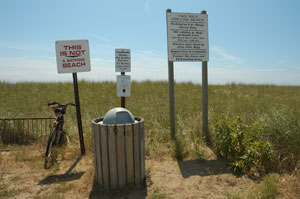'Gay Beach' Is Singled Out For Guard Patrols, Jet Skis swoop down on Two Mile Hollow

Accused by the Suffolk County Health Department of operating a bathing beach without a permit, proper supervision, or bathrooms, East Hampton Village installed portable toilets at Two Mile Hollow Beach on Friday and agreed last week to patrol the beach for the rest of the summer to remind people that swimming is not allowed there.
If the village does not comply with the terms of the agreement, the Health Department can impose fines of up to $2,000 a day and order the beach closed until the village gets a bathing beach permit.
The Health Department has given the village until May 27, 2006, to get the permit. A bathing beach, as defined by the state sanitary code, must have public bathrooms, full-time lifeguards, and lifesaving equipment. Health Department officials had not returned calls as of press time.
Because it is too late in the season to staff the beach, Larry Cantwell, the village administrator, said the village has opted instead to have the Police Department and village lifeguards pay regular visits to Two Mile Hollow to "advise people" there that they swim at their own risk.
Those visits, which began last week just as beachgoers were seeking refuge in the water from some of summer's most oppressive heat and humidity, came as a surprise to many. With little explanation offered for the sudden change in procedure, some at Two Mile Hollow said they felt it was being singled out because it is popular with the gay community.
"It's obvious that it is just this beach," Brian Moran of East Hampton said on Aug. 3. "It's because it's the gay beach."
"That's the furthest thing that we want to portray here," Village Mayor Paul F. Rickenbach Jr. said Monday. "Historically, that beach has been used by the gay community, but it's also used by a fair number of families." The mayor said he explained the situation to the leaders of the East End Gay Organization.
According to those who were at the beach on Aug. 3, lifeguards arrived offshore on Jet Skis and village police rode all-terrain vehicles onto the beach to tell them that they were not allowed to swim in the ocean. One person said a lifeguard had told him he could be ticketed if he went in the water.
For years there have been signs at Two Mile Hollow, Old Beach Lane, and Wiborg's Beach, all of which are within the village, warning that they are not bathing beaches. In posting the signs, "We thought we had lived up to the intent of a stipulation made back in 1976," the mayor said.
"As long as people using the areas were advised . . . that was adequate in a rural environment," Mr. Cantwell said yesterday, and no one complained about the lack of a bathroom or lifeguards.
Two years ago, neighbors calling themselves the Further Lane Association began to complain to police about problems at the beach. They hired private investigators to patrol it for several weeks and to videotape evidence of public urination, public sex, trespassing on the dunes, and littering. Police responded by stepping up patrols of the beach and in one night arrested several people for public lewdness and disorderly conduct.
As the dust settled, the Further Lane Association proposed in a letter to the board that the beach be open only during the day and that it be established as a bathing beach with lifeguards.
There had been few problems since then until last month, when police received a number of similar complaints. Apparently, someone also called the Health Department, Mr. Cantwell said.
Health inspectors visited the beach on July 22 and 23 and cited the village with several sanitary code violations. The village was to have answered those charges in Yaphank on Aug. 16, but instead reached an agreement to meet the department's mandates, including that the village regularly enforce its "policy of not allowing bathing at Two Mile Hollow Road and other unprotected beaches within the village borders."
Despite its citations concerning Two Mile Hollow, the mayor said the Health Department did not have a problem with the situations at Wiborg's or Old Beach Lane. Mr. Cantwell said he could only assume that the department was more concerned about Two Mile Hollow because its 200-car parking lot is so much larger than those at other non-bathing beaches.
Beachgoers unaware of the Health Department's mandate were confused by the presence of lifeguards and police last week.
"It's a village beach, you pay for a parking permit," said Scott Newman of East Hampton, who has gone to the beach for 15 years.
"I've never seen them stop people swimming, never,"
said Helena Flecker, who lives in Springs and has been going to the beach for five years.
More than a dozen people on Wiborg's Beach that same day said that neither the lifeguard on the Jet Ski nor the police on the A.T.V. had stopped anyone from swimming in the ocean.
Ed McGintee, the village's head lifeguard, based at Main Beach, said lifeguards regularly patrol both Wiborg's and Two Mile Hollow Beaches. "We always go there, since we got the Jet Ski," he said.
At its next meeting on Friday, Aug. 19, the village board is expected to discuss plans for the bathrooms. The mayor said that Two Mile Hollow will be a supervised bathing beach next summer. The meeting will be held at 11 a.m. at the Emergency Services Building on Cedar Street.
With Reporting by Jonathan Saruk
